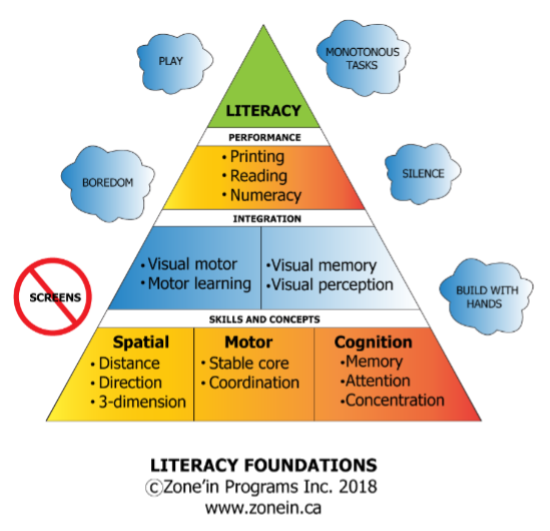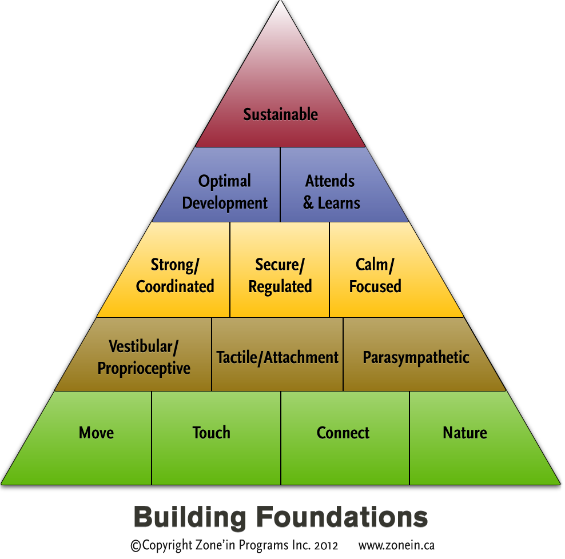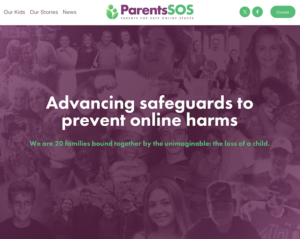Despite numerous studies showing academic decline with increased use of computers in schools, education governments continue to push online learning, a teaching method which became universal during the recent pandemic. Prolific research shows negative association between overuse of screens with student cognitive, physical, social and mental performance. Yet during Covid school closures, governments mandated children and teachers to sit in front of screens for up to 7 hours per day. Isolated, overstimulated, neglected and sedentary at home and now in school, the new millennium child’s very sustainability is now in question. An obvious, research evidenced solution to perils associated with online learning is outdoor classrooms. During previous pandemics in the early 1900s, education systems wisely moved classrooms outside, thus providing children with quality in person education in an outdoor environment. Ignoring health guidelines, lack of supporting research and common sense, governments worldwide continued to cause irreparable harm to children and teachers through mandated online learning. This article provides evidence that school-based technology is contributing to documented declines in student cognitive, physical, emotional, mental and social performance and reviews expert recommendations on how to reverse this disastrous trend. Critical factors for achieving optimal child development and learning are reviewed and in/outdoor school concept is outlined. Do No Harm education technology policy is proposed by writer. Acting together to reduce the use of screens and increase access to healthy activities, we can create sustainable futures for all children.

What the Studies Tell Us
The education sector continues to operate under the false impression that all children need to be proficient in computer skills to compete in the job market upon graduation, yet The World Economic Forum (WEF) reports otherwise. Out of the 15 top jobs listed in the WEF Future of Jobs Report 2020, only 5 are technology based with the top 2 being ‘analytical thinking and innovation’ and ‘active learning and learning strategies’. Prior to the pandemic, the Organization for Economic Co-operation and Development (OECD) published a 2015 study Students, Computers and Learning: Making the Connection which documented no appreciable improvements in student achievement in reading, mathematics or science (see below graphs) in countries that had invested heavily in information and communication technologies (ICT) for education. The OECD went on to report that “Ensuring every child attains a baseline level of proficiency in reading and mathematics seems to do more to create equal opportunities in a digital world than can be achieved by expanding or subsidizing access to high-tech devices and services”.




This impression that all children need to learn digital code has dramatically changed education curriculum from teacher driven to screen driven, forcing many schools into education technology practices which not only are harming children, but also eroding foundations for learning and literacy attainment. During the recent pandemic the Horace Mann Educators Corporation survey of 941 US educators in Feb. and Mar. ’21 found that more than half of public school K-12 teachers said the pandemic resulted in a “significant” learning loss for students, both academically and in their social-emotional progress. McKinsey and Company study of 8 countries showed that teachers ranked the efficacy of online learning only slightly better than skipping school altogether, that the attainment gap between public and private school students has widened, and concern among educators that the stress and isolation from online learning is contributing to mental health issues among young people.

A study by the Centers for Disease Control and Prevention stated that virtual learning presents more risks than in-person instruction related to child and parental mental and emotional health reporting that 62.9% of parents with children learning from home said their kids were getting less exercise, 58% said they were spending less time outside, 86.2% said they were spending less time hanging out in person with friends and 24.9% said their kids’ mental or emotional health had worsened. Regarding effects of online learning on parents, the CDC study went on to report that 54% of parents with kids in virtual school said they suffered from increased emotional distress, 16.4% said they were increasingly using drugs or alcohol and 21.6% said they had trouble sleeping at night; these issues were less prevalent among parents with kids attending school in person. A 2022 parent survey reported that child behavioral outcomes tended to be worse during remote schooling than during in-person schooling with hybrid learning falling in between e.g. better than remote, worse than in-person.
We do know that the risk of contracting Covid is reduced markedly when children are outdoors substantiated by a review of 7,000 Covid cases in China which recorded only one instance of fresh-air transmission. The Children and Nature Network – Research Library has an extensive database of research articles showing improved student attention, learning, participation, attendance and academic performance when learning outside with a significant reduction in problematic behaviors when compared to traditional in school learning.
What the Experts Recommend

The American Academy of Pediatrics published an extensive policy document for school which was last updated Nov. 2, ’21 advocating for students to return to the classroom stating “opening schools generally does not significantly increase community transmission, especially when guidance outlined by the World Health Organization (WHO), United Nations Children’s Fund (UNICEF), and Centers for Disease Control and Prevention (CDC) is followed. The World Health Organization released guidelines last updated Oct. 21, ’20 stating that “school closures should be considered only if there are no other alternatives”. Regarding teaching methodologies, the OECD reports “schools should focus on achieving baseline proficiency in reading and math without use of digital devices” a concept illustrated by author graphic Literacy Foundations. Achieving printing, reading and numerical literacy requires foundations in spatial concepts, motor skills and cognition. Printing is a precursor to reading and math as children who do not have subconscious and speedy printing skill fail in every subject, yet printing is rarely taught today in a structured or sufficient manner. Abstaining from screen use until achievement of grade 3 literacy is a very good idea.
What Children Need to Grow and Succeed
 Growing a child for academic success is like building a house, it’s all about creating a solid foundation comprised of adequate movement, touch, human connection and nature depicted by author graphic Building Foundations. Health Canada’s Movement Guidelines released in 2021 recommend children sweat 1 hr/day, step 2 hrs/day, sit < 2 hrs/day and sleep 9-11 hrs/day. We’ve known since the early 1900 orphanage studies that children deprived of human touch and connection have significantly higher rates of physical impairments and mental illness. Nature activates the parasympathetic system inducing calming and improved attention and learning (refer to Resource section end of this article for additional information on outdoor schools). All time spent on screens prohibits child engagement in these 4 critical factors for growth and success, and is consequently detrimental to child development, attention and learning. Incorporating these 4 critical factors into school curriculum is much easier in an outdoor learning environment as children automatically engage in more movement, rough and tumble play and social interactions in nature’s playground. Many school districts have already implemented outdoor classrooms with astounding success, so knowledge and evidence regarding this teaching methodology is already in place. Funding sources would be through costly technology reduction. In/outdoor school concept is simple in that half the classroom is outside in the AM and moves inside in the PM. This concept not only achieves harmful screen reduction with replacement of healthy activities, but also meets Covid criteria for distancing and lowered transmission rates.
Growing a child for academic success is like building a house, it’s all about creating a solid foundation comprised of adequate movement, touch, human connection and nature depicted by author graphic Building Foundations. Health Canada’s Movement Guidelines released in 2021 recommend children sweat 1 hr/day, step 2 hrs/day, sit < 2 hrs/day and sleep 9-11 hrs/day. We’ve known since the early 1900 orphanage studies that children deprived of human touch and connection have significantly higher rates of physical impairments and mental illness. Nature activates the parasympathetic system inducing calming and improved attention and learning (refer to Resource section end of this article for additional information on outdoor schools). All time spent on screens prohibits child engagement in these 4 critical factors for growth and success, and is consequently detrimental to child development, attention and learning. Incorporating these 4 critical factors into school curriculum is much easier in an outdoor learning environment as children automatically engage in more movement, rough and tumble play and social interactions in nature’s playground. Many school districts have already implemented outdoor classrooms with astounding success, so knowledge and evidence regarding this teaching methodology is already in place. Funding sources would be through costly technology reduction. In/outdoor school concept is simple in that half the classroom is outside in the AM and moves inside in the PM. This concept not only achieves harmful screen reduction with replacement of healthy activities, but also meets Covid criteria for distancing and lowered transmission rates.
Do No Harm Educational Technology Policy
The following policy recommendations were designed by author and are further elaborated on in upcoming Technology Management Webinars for educators.
- Movement and nature: ensure 50/50 time spent in/outdoors; use ‘body breaks’ not ‘tech breaks’.
- Ban all cell phones and social media: from classrooms, school grounds and offsite events; teacher devices out of sight; supervise all student online activity.
- Achieve literacy first: no screens until achieve grade 3 literacy; curriculum guideline should include McLean’s standardized printing instruction, deep reading, manipulative math.
- Ensure safe and effective edtech:
-
- Don’t exceed expert guidelines for duration or content.
- Never use tech as a reward.
- No entertainment technologies; school is for learning.
- Edtech should pass ‘High Quality Research’ criteria and standards.
- Ensure student data privacy (certified products, liability signatures).
- Cable all wireless devices (Ethernet or fiberoptic).
Resources
- Green Space – Landscape and Human Health Laboratory, Univ of Illinois. lhhl.Illinois.edu/
- Green School Yards – greenschoolyards.org.
- Last Child in the Woods – richardlouv.com.
- Children and Nature Network – childrenandnature.org.
- Forest Schools – forestschools.com, courses.
- OutClass Outdoor Classrooms – outdoorclassrooms.com, equipment.
- Inside Outside – insideoutside.org, cold weather.
- Learning With Nature Idea Book – arborday.org.
- Wild BC – wildbc.org; environmental education.
This article was written by Cris Rowan, biologist, pediatric occupational therapist, sensory specialist, author of “Virtual Child” and international speaker. Cris can be reached at info@zonein.ca.
Feature Image Credit: Bureau of Charities, via Library of Congress





2 Responses
Hi Allan,
Thank you so much for bringing my awareness to at home – online learning programs (such as Traditional Learning Academy) and their difference with government mandated online learning. I particularly like that “we use the computer to manage the student’s program, not to teach it” and “most of our early grades use paper-based resources – not on-screen programs”. It sounds as if you understand that computers can’t teach and that achieving foundations for literacy need paper/pencil and humans. Moving forward, I’m wondering if yourself and others could provide suggestions regarding possible ‘technology usage guidelines’ which would help promote learning and literacy. A few to get started…
1. No screens until grade 3 literacy achieved.
2. No entertainment technology in/around schools e.g. movies, video games, social media, porn.
3. ???
Dear Cris
I have been a fan of your focus on the pitfalls of technology and screen time for kids since I attended one of your early workshops in Surrey, many years ago. Since then, I have watched as you reached international fame for your workshops, webinars, articles and books. When I got this email today, I was glad to see you ‘back in business’ after this crazy time. However, when I read your lead article, I said, “Oh no, Cris!” You are right on with observations about ‘online learning’, but your description of this fails to acknowledge the existence of designated in-home learning. Let me explain.
In 1989, I left the Vancouver School system after 25 years, 13 of which I was an elementary principal. I was upset over the trends emerging in public education and the tendency of teachers to take on the role of parent (which is still all too prevalent today.) In 1991, I started an independent school (Traditional Learning Academy — TLA) determined to educate children using the best curriculum and teaching that had worked in the past. Not everything old was good, so we had to be selective, but the school has thrived since and sent hundreds of competent, well-rounded into the world. Parents are glad that there is still a school that uses an effective approach to get remarkable results. At the same time, home-schooling was getting a foothold (it was legalized in1988), and we offered support to parents to ensure they had good resources and help where necessary to allow them to educate their children. By 2001, we registered over 1500 homeschoolers, about 1/3 of the provincial total. Not too long later, “electronic learning’ came into the picture, and the Ministry of Education allowed students to learn at home, but under the direction of a certified teacher who was responsible to ensure these students achieved the outcomes of provincially prescribed curriculum. Home schooled children, under direct responsibility of their parents and not accountable to the Ministry, were not able to receive a graduation certificate, but the students in an electronic learning system could. The Ministry inspected these programs to ensure they fulfilled their duty. After several evolutions of the home learning approach, it is alive and well. It was called ‘distributed learning’ for years, but recently the Ministry is restructuring the system, and is now referring to these programs as ‘online learning’. TLA was onboard from the beginning with this innovative approach that offered parents a way to keep their children in legitimate school program, but in the home setting.
My appeal to you, and the reason I am sending this to you, is to ask that you not confuse what happened during school closures during the pandemic with online learning schools, set up to be accountable for each student’s learning program. The teachers in these schools have learned how to oversee the learning programs, requiring a very different approach. In-school teachers in schools that were closed (tragically – not necessary) were told to teach their children online! Most of them did not have a clue what to do, and they did not have access to proper curriculum resources and program management needed to properly maintain any semblance of actual learning. It was, and is, totally inappropriate, and your comments here are on the money. My appeal to you, though, is not to assume that online learning in a legitimate online school is not effective. We have decades of experience and super grads to show you what is possible.
We still have a K – 12 traditional school in Coquitlam, but our home learning program (TLA Online – http://www.schoolathome.ca) operates out of facilities in Cloverdale. In the latter, we have over a thousand students from all over BC, including about 200 funded special needs students who are making marvelous progress under the direction of trained special needs teachers, using educational assistants where needed. I would encourage you to come to our site to meet with the Principal, Gabe Linder, who would be helpful in telling you what we do and answering your questions. (1-800-745-1320).
I forwarded your newsletters to our teachers on many occasions over the years to make them aware what you were promoting – too much screen time, for example. Does this sound contradictory? An online learning program, but cutting down screen time? Not at all. You should know that we use the computer to manage the student’s program, not to teach it. Most of our early grades us paper-based resources – not on-screen programs. Toward high school, however, the computer is used more, but to access resources, receive guidance, quizzes and other tests. Knowing what you promote, I have no trouble telling you we are on the same page for the most part. Please come and visit when you are in town!
Respectfully submitted,
Allan Garneau